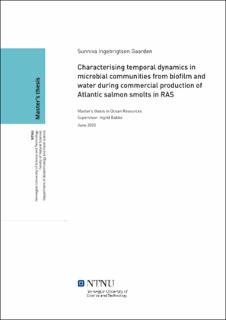| dc.contributor.advisor | Bakke, Ingrid | |
| dc.contributor.advisor | Dahle, Stine Wiborg | |
| dc.contributor.advisor | Attramadal, Kari Kihle | |
| dc.contributor.author | Gaarden, Sunniva Ingebrigtsen | |
| dc.date.accessioned | 2020-08-06T16:00:22Z | |
| dc.date.available | 2020-08-06T16:00:22Z | |
| dc.date.issued | 2020 | |
| dc.identifier.uri | https://hdl.handle.net/11250/2671131 | |
| dc.description.abstract | Resirkulerende akvakultursystemer (RAS) har økt i popularitet i norsk oppdrett av atlantisk laksesmolt (Salmo salar). Muligheten til intensiv og kontinuerlig produksjon ved optimale temperaturer gjennom hele året, i tillegg til et lavt ferskvannsforbruk er noen av grunnene til at RAS har økt i popularitet i Norge. Selv om mikroorganismer kan ha en stor effekt på vannkvalitet og fiksehelse i RAS, finnes det lite kunnskap om de mikrobielle samfunnene under normal kommersiell drift.
Denne studien hadde som mål å karakterisere de mikrobielle samfunnene i biofilm og vann fra et kommersielt driftet RAS-anlegg, ved kommersiell startfôring av laksesmolt. For å studere disse mikrobielle samfunnene ble det tatt prøver annenhver uke, i over 15 måneder. Prøvene ble tatt fra fire ulike deler i RAS-loopen: Biofilm- og vannprøver fra to fisketanker, biofilm fra et biofilter og vann fra en sump etter biofilteret. Totalt ble 245 prøver sendt inn til Illumina-sekvensering av 16S rRNA genet og disse lå til grunn for den videre analysen av den mikrobielle sammensetningen. I tillegg til disse prøvene ble det tatt vannprøver for å estimere antall bakterier, andelen opportunistiske bakterier, det bakterielle vekstpotensialet og den bakterielle kultiverbarheten.
De mest tallrike ordenene i både biofilm- og vannprøver var Rhodobacterales, Burkholderiales og Sphingomonadales. De mikrobielle samfunnene var signifikant forskjellig fra hverandre i biofilm og vannprøver. De mikrobielle samfunnene i vannprøver var like i fisketankene og det behandlede vannet fra vannsumpen, men varierte over tid. Den gjennomgående likheten i vannmikrobiota var mest sannsynlig forårsaket av en lav HRT i fisketankene. Det var flere sakte-voksende bakterier og et lavere bakterielt vekstpotensial i det behandlede vannet i vannsumpen sammenlignet med vann fra fisketankene, dette foreslår at den mikrobielle vannkvaliteten var bedre i det behandlede vannet sammenlignet med vann fra fisketankene. Mikrobiotaen i biofilm fra fisketankene var signifikant forskjellig fra samfunnene i biofilm fra biofilteret. Biofilmsamfunnene i biofilteret var mer stabile i sammensetning enn biofilmsamfunn fra fisketankene. Det ble funnet store variasjoner i relativ forekomst av nitrifiserende i biofilm fra biofilteret. Nitrospira var den mest vanlige nitrifiserende i biofilteret og det ble oppdaget at en av Nitrospira-OTUene var i slekt med tidligere karakteriserte COMAMMOX bakterier. I tillegg var det lav relativ forekomst av ammoniakk-oksiderende bakterier.
Denne masteroppgaven har gitt ny kunnskap om de komplekse mikrobielle samfunnene i startfôring av laksesmolt i et kommersielt RAS. Resultatene kan implementeres i fremtidig forskning for å forbedre hvordan vi forvalter mikrober i fiskeproduksjon i RAS. | |
| dc.description.abstract | Recirculating aquaculture systems (RAS) have become increasingly popular as a production system for Atlantic salmon smolts (Salmo salar) in Norway. Advantages such as the possibility of intensive and continuous production at optimal temperatures throughout the year, in addition to low freshwater consumption are some of the main reasons for the increasing popularity. Microorganisms can have great impacts on water quality and fish health in RAS. However, little is known about microbial communities in different units of commercial RAS during normal operation.
This study aimed to characterise the microbial communities in biofilms and water from a commercially operated RAS, during start-feeding of Atlantic salmon smolts. To study the microbial communities, samples for microbial community analysis were collected biweekly over 15 months from four different units inside a RAS-loop: water and biofilm samples from each of two rearing tanks, biofilm samples from a biofilter and water samples from a water sump downstream from the biofilter. A total of 245 samples were subjected to microbial community analysis by Illumina sequencing of 16S rDNA amplicons. To supplement the microbial community analyses, additional water samples were taken to quantify the number of bacteria, estimate the ratio of opportunistic bacteria, the bacterial growth potential and the bacterial cultivability.
The most abundant orders in both biofilm and water samples were Rhodobacterales, Burkholderiales and Sphingomonadales. Moreover, the microbial communities in biofilm and water were found to be significantly different from each other. Microbial communities in rearing tanks and the treated water in the water sump were similar, but varied over time. The similarity in water microbiota throughout the sampled RAS were believed to be caused by a low HRT in the rearing tanks. There were more slow-growing bacteria and a lower bacterial growth potential in the treated water in the water sump compared to the rearing tank water, suggesting a better microbial water quality in the treated water compared to the rearing tank water. The microbiota of rearing tank biofilm was significantly different from communities within biofilm from the biofilter. The biofilm communities in the biofilter were found to be more stable over time than biofilm communities from the rearing tanks. Large variations in relative abundance of nitrifiers were found in the biofilter biofilm. Nitrospira was the most abundant nitrifier, and one of the Nitrospira OTUs were found to be related to previously characterised COMAMMOX. There were in general low abundances of ammonia-oxidising bacteria.
This thesis has provided new knowledge on the complex microbial communities in start-feeding of salmon smolts in a commercial RAS. The results can be implemented in further research, to improve microbial management of fish production in RAS. | |
| dc.publisher | NTNU | |
| dc.title | Characterising temporal dynamics in microbial communities from biofilm and water during commercial production of Atlantic salmon smolts in RAS | |
| dc.type | Master thesis | |
